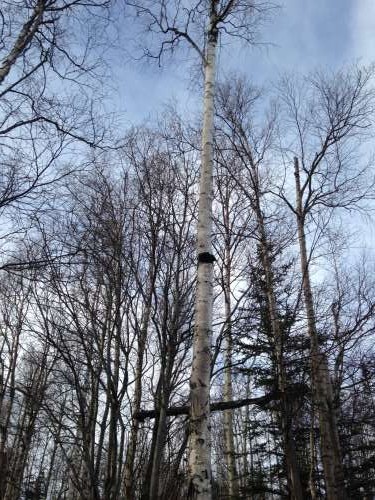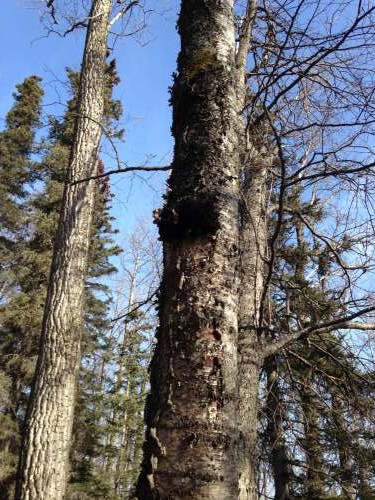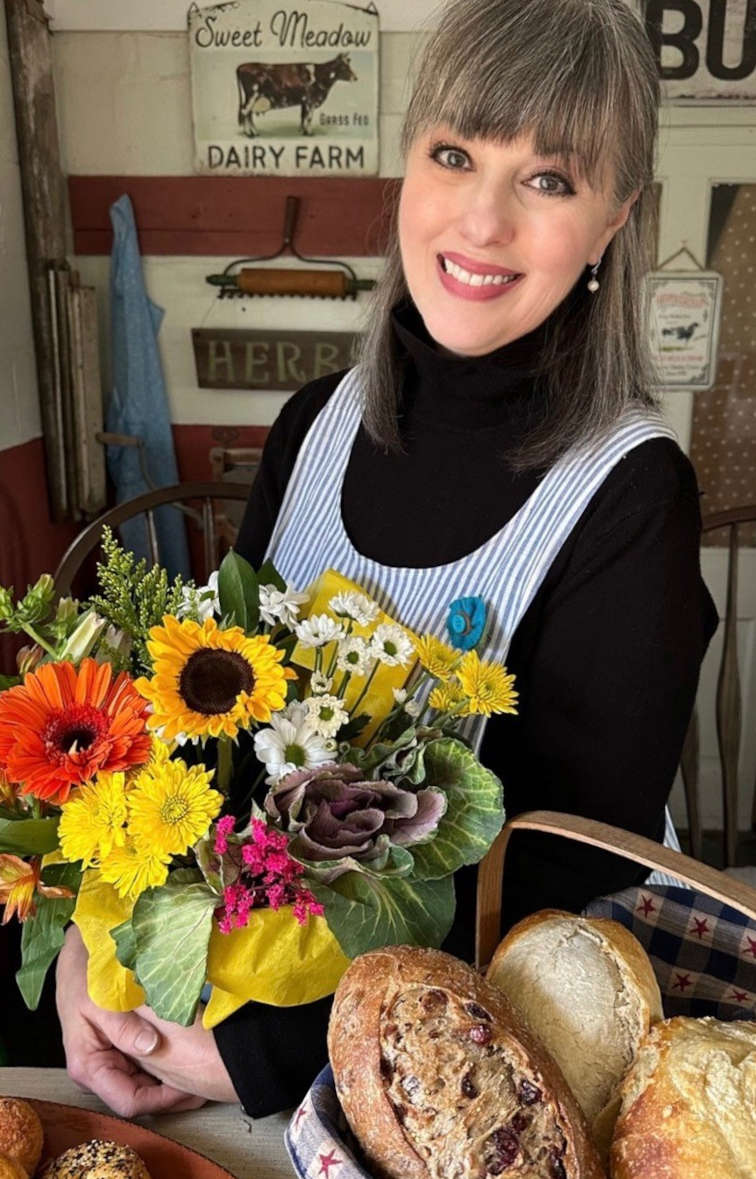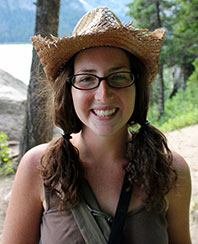Foraging for wild edibles has been one of my favorite activities since childhood. My mother hunted (and continues to hunt) for wild puff ball mushrooms, morels, wild ramps and fiddlehead ferns. We tapped maple trees in our yard and enjoyed the spoils of our relative’s hunting and fishing outings. I’ve eaten cattail, wild sorrel, various wild berries, fire weed, spruce tips, and many others. We’ve even made salves, teas and balms with foraged plants and herbs.

What is that black spot on that birch?! is it a nest? a burl? It’s chaga!
While agriculture is one of my great passions, Mother Nature has a way of cultivating some of the best culinary flavors and textures. Wild medicinals are a newer interest, and they are also a little more controversial. Their controversy lies in the lack of science behind many folk remedies–there isn’t much money for research when BigPharma isn’t making money off of the product! While I do love science and turn to it for making many of my decisions, I also think there is credence in the generations of knowledge and use that come with traditional foods and medicines.
This is where we come to chaga, also known as cinder conks, or “The King of the Mushrooms.” It is a parisitic fungus that grows on trees in the northern temperate regions of the world: Russia, Northern Europe, Korea and Northern China, Canada and northern parts of the United States. It grows on many species of trees, but the desirable chaga grows on betula species of trees, more commonly known as birch! Birch trees have many healing properties on their own. Because of the chaga mushroom’s parasitic qualities, it takes on some of these properties–most notably betulinic acid. Betulinic acid has antiretroviral, antimalarial, anti-inflammatory and cancer fighting properties.

Chaga after harvesting; photo courtesy of Evan Pederson
Chaga is known as an “adaptogen” which means that it helps one regulate, reduce and adapt to environmental stressors (ginseng is a more widely known adaptogen). It benefits the immune, endocrine, cardiovascular and nervous systems. It also helps treat auto-immune conditions like psoriasis, fights cancer, helps prevent colds and flus during the winter months, and supposedly helps with seasonal affective disorder. It has been used for centuries in Russia and China for ailments of the stomach, liver, and heart, as well as a tonic, blood purifier, and pain reliever. While none of these claims have been scientifically proven or approved by the FDA, the compounds found in the mushroom and studied individually support these claims. It is even sold in Russia as a cancer treatment.
While chaga does fight some pretty major disorders and diseases, it is commonly drank as a daily tea–especially in the fall and winter months. Users of the medicinal mushroom claim that it must be consumed almost every day for two months or more for noticeable and lasting effects.
I had never heard of this mushroom until a few days ago when I read an article that someone had linked to on Facebook. I was immediately intrigued! The most appealing part about this wild medicinal is that it should be harvested during the winter! While the winter is largely coming to an end, we are just at the tail end of it here in Alaska. When I heard that someone had been poaching chaga from private property a few days ago, I figured it was still early enough for harvesting (perhaps that was a bad assumption…but the sap isn’t quite running yet, so I think it’s okay). I’m excited to have a foraging option for the winter! Something that can be harvested on skis is pretty cool in my book.

Our first positive ID. It’s hard to see in the photo bc the sun is coming from opposite the mushroom.
My farmer friend Melisse, her son who is Ava’s age, Ava and I all went out last week to search for this sometimes elusive fungus. It is pretty easy to identify–it looks like a big burnt tumor on the trunk of older birch trees. I have actually seen it many times but never realized that it was a fungus! I always thought that it was some sort of protective scab on damaged trees (which it is, in a sense). It didn’t take us very long on our hike until we found several samples of the mushroom. It is very slow growing, so we didn’t harvest all of it that we saw, and we made sure to leave most of the mushroom on the tree so that it could regrow a bit easier. I read that some people harvest it improperly, opening up big wounds which can kill the trees.

Climbing to get our treasure! Photo courtesy of Melisse.
Some people might have special chaga harvesting tools, but I just used a hammer and a flat head screw driver as a pick. Most of the samples were high enough in the trees to necessitate climbing a bit, so I was excited to take on this challenge! Climbing trees to collect amazing naturally occuring medicine?!? Count me in.
I ended up with several sizeable chunks of chaga, most of which are in the process of drying. I did take a chunk out to test out as a tea that I’ve had for the last few days. It can also be made into a tincture, or consumed in edibles. Many people grind it up into a fine powder for tea, but I think I’ll stick with it in chunky form. I just put some chunks in a pot of simmering water for about 20 minutes. I then pour it into a cup with some spices (ginger, cinnamon, cardamom), honey and some milk. It is yummy! slightly bitter like coffee or black tea and a bit nutty. It reminds me of dandelion root tea, a bit. The chunks can be re-used until they lose their color. One account says that she leaves a pot on the stove all winter and because of the chaga’s sterile and anti-bacterial properties she has never seen it ferment or go bad.

Our medicinal booty.
I have yet to feel anything revolutionary, and I probably won’t drink this tea religiously, but it is a fun and healthful option to add to my repertoire! Obviously, I am not a doctor, herbalist or nutritionist of any sort, so don’t just listen to me. Do some research on your own and see if this wild medicinal is for you!
Some sources claim a few contraindications to chaga consumption–most notably possible interactions with other drugs. From what I read the problems mostly lie with blood thinners and diabetes related treatments. However, like with any supplement or medicine, you should consult with your medical care provider before treating yourself, especially if you are taking other medication.
Have you heard of chaga? Have you used it in any form?

Babies in the forest!! They had so much fun stomping in puddles, picking up spruce cones and exploring their surroundings.
If you live in the north, I suggest going for a hunt in a birch stand near you! Even if you don’t find or harvest any of this “King of the mushrooms,” a walk in the trees is a wonderful way to while away some time.
Happy spring to all and to all a healthful season!
Until next time,
Sending you peace and love from AK,
Alex, the Rural Farmgirl











I heard about chaga from the president of the Mycological Society in San Francisco. He recommended four types for my anti-cancer diet. We have many foragers who work with Far West Fungi and although shiitake and maitake mushrooms are fairly easy to obtain, the chaga is a bit rare. I use the dried mushrooms in soups but haven’t tried them in tea yet. Thank you for letting us know about these amazing fungal helpers!
The Mycological Society sounds like it must be full of fun guys (and gals!). Ha. Ha. I bet they never hear that one. I read somewhere that chaga is present on one of every 10,000 birch trees. However, I have seen it a lot up here, even spotting it from my car several times. We must be in the ideal climate! I should try mine in a soup. Yum.
Great article!! I too have been into the ‘wild’ side of eating – just because it is there, never heard of chaga, probably because I don’t live where birch grow nicely. Also love the pic with the babies – who are growing so fast – to double precious they are. God bless.
Thanks, Joan! I like that–the “wild side”–it must harken back to our hunter/gatherer ways. Although, now instead of survival we gain great pleasure in the hunt. Those babies are growing SO fast. I can’t believe they are walking and babbling together. Soon they will be able to forage with us!
A close friend who is a 20+ year herbalist and a RN, introduced me to chaga last year. It is found here in the Catskill mountains of NY, so I have a great supply. I started having gastro-intestinal problems and after an endoscopy found just mild irritation at the base of my esophagus, I began to have pain in my stomach; kept me up at night and it hurt! My friend told me to start with the chaga tea again (I had stopped last year….don’t know why)…and the first night I drank it (about 4 – 6 oz each evening), the pain was gone. It’s now an every-day thing for me. …… When you first make the chaga tea, you should place it in a glass (never use metal….no pots, no utensils) pot (I use Corningware)…about 2 tablespoons…and cover with at least 16 oz of water (or until you can’t see the chaga pieces). Let soak, covered, overnight. The next day, bring to a SIMMER (never boil) for 30 minutes or so, with lid askew for venting. Then, cover fully, again, and let sit overnight or for 8 hours. The next day, simmer again for 30 minutes….and now it’s ready. It takes time for the water to extract the nutrients from the hard chaga mushroom. Every day, when you take some out to drink, replace the liquid you removed with fresh water….you always want to keep the mushroom pieces covered. Mine usually lasts like this for 2 – 3 weeks!! It never gets spoiled. If, for some reason, you do see spoilage (mold, etc.), toss it. When the tea starts to lighten (when you can see the mushroom pieces), it’s time for a new batch. I take those pieces, and dry them on a plate for a few days (crumbs and all). Then I run it through a blender (to start getting the pieces smaller….they are tough!) and then a coffee grinder. Use the “chaga flour” for baking! No waste! …… Thanks for posting this article and for reminding readers about responsible harvesting. Chaga takes a very, VERY long time to grow. ~~Peace!~~
Wonderful, Barbara! Thank you for your insight and incredibly useful tips. This is how I will be preparing my chaga from now on. Peace to you as well!
I never heard of Chagra, but I am familiar with adaptogens. I use Astragulus which is s one adaotogen that also fights some forms of cancer and other fungus . I take it on occasion now, but took it regularly to fight tumor growths. It also is good for other reason.
But you need to be very careful cause it is a fungi. Some fungus can have a reverse affect. And cause sicknesses and diseases. I used yo walk barefoot and got a white fungus growing in my feet. Fungus , black and some more toxic can actually kill a child. Please be careful in hour harvesting if fungi…..be certain you know fir certain f their vale. I would never feed it to a child.
Thanks, Susana. I only harvest mushrooms that I am very certain of. I am a trained naturalist and have taken mycology courses. Many mushrooms and fungi are poisonous and are easily misidentified as edible. Chaga is easily identifiable.
Hi Alex,
I loved reading about the Chaga. I’d never heard of it before. What an awesome thing it is to forage and harvest things in the wild and then to have the courage to actually use it. I think I am sort of a baby that way… 🙂
I was reading your comments and loved the one from Barbara. This Chaga must be the most amazing thing. I’m thinking I need to check into it!
Thanks for the post. Awesome as always! – Dori –
Thanks, Dori! I love wild foraging, but I am always certain that it has been correctly identified before ingesting. The most worrisome things to harvest are berries and mushrooms as they can go fatally wrong. I would recommend taking some classes from your local extension office or something similar. I bet those hills around you have some pretty great treasures!
Hello Alex and thank you for your blog about Chaga. It’s interesting read the comments others have sent you. My company makes 8 flavors of tea + honey – that is raw, unfiltered honey infused with organic herbs. Our “Mocha Chaga” tastes like cocoa because it has a lot of cacao, but at the same time each cup has a goodly amount of powdered Chaga. Ours is wild-harvested by our son in mid-central Maine. I drink a plain Chaga tea every day to reduce my sugar numbers and I’m thrilled to say it really works! So thanks for spreading the word, Alex. If you’d like to know more about our teas just go to our website: zenbearhoneytea.com Cheers
Hello Alex and thank you for your blog about Chaga. It’s interesting to read the comments others have sent you. My company makes 8 flavors of Honey Tea – that is, raw, unfiltered local honey infused with organic herbs and teas. Our “Mocha Chaga” tastes like cocoa because of the cacao, Lucuma and sea salt, but it also includes a goodly amount of powdered Chaga. All the ingredients infuse in the honey, so you just add a spoonful to hot water to make a great cup of tea. I drink plain Chaga tea every day to reduce my sugar numbers. It works! Our Chaga is wild-harvested by our son in central Maine, but as you say, Chaga lives in all the world’s boreal forests. Thanks for spreading the word about Chaga. Check out our website for more info. on all our teas: zenbearhoneytea.com Cheers Lisa
wondering best place to buy raw or chunk chaga in salt lake city